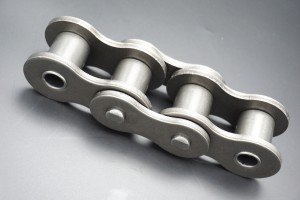What Automation Technologies Are Available for Roller Chain Lubrication Systems?
In modern industrial production, roller chains, as a crucial transmission element, are widely used in various mechanical equipment and conveying systems. To ensure efficient operation and extend the service life of roller chains, automation technologies for lubrication systems are particularly important.
1. Overview of Automation Technologies for Roller Chain Lubrication Systems
Automation technologies for roller chain lubrication systems aim to achieve timed, quantitative, and uniform lubrication of roller chains through automated means, thereby improving lubrication efficiency, reducing manual intervention, and lowering maintenance costs. These technologies typically include the following aspects:
(I) Basic Components of Automatic Lubrication Systems
Automated lubrication systems typically consist of the following key components:
Lubricant reservoir: This is used to store lubricating oil or grease and is typically equipped with a level sensor to monitor the remaining lubricant.
Pumping device: This can include an electric, pneumatic, or hydraulic pump and is used to deliver lubricant from the reservoir to the lubrication points.
Distributor: This evenly distributes lubricant to each lubrication point, ensuring that every connection point in the chain is fully lubricated.
Controller: This controls the operation of the lubrication system, including setting parameters such as lubrication frequency and lubricant quantity. Sensors: Used to monitor the operating status of the lubrication system, such as lubricant pressure, temperature, and flow.
(II) Working Principle of Automation Technology
Automated lubrication systems use sensors and controllers to monitor and automatically lubricate roller chains in real time. When the sensors detect the chain’s need for lubrication, the controller automatically activates the pumping device, delivering lubricant to the distributor, which then evenly distributes it to each lubrication point. This automated lubrication method ensures timely and accurate lubricant supply, avoiding problems caused by under- or over-lubrication.
2. Application Areas of Automation Technology for Roller Chain Lubrication Systems
Automation technology for roller chain lubrication systems is widely used in various industries, especially in environments with high lubrication requirements, where its advantages are particularly evident. The following are some of the main application areas:
(I) Food and Beverage Industry
In the food and beverage industry, automated roller chain lubrication system technology is widely used in equipment such as ovens, processing equipment, and conveyor belts. These equipment often operate in high-temperature and high-humidity environments, placing high demands on lubricant performance and safety. Automated lubrication systems ensure that lubricant supply meets food safety standards while reducing manual intervention and contamination risks. (2) Automotive Industry
In the automotive manufacturing process, automated roller chain lubrication systems are used in equipment such as body pre-treatment coating, paint ovens, and conveyor belts. These equipment operate in high-temperature, high-load environments, placing high demands on lubricants with high-temperature resistance and wear resistance. Automated lubrication systems ensure timely and accurate lubricant supply, extending chain life and reducing downtime.
(3) General Industry
In general industry, automated roller chain lubrication systems are used in various conveyor belts, transmission equipment, and processing equipment. These equipment often operate in diverse environmental conditions, placing high demands on lubricant adaptability and reliability. Automated lubrication systems can automatically adjust lubricant supply based on the equipment’s operating status, ensuring efficient operation.
3. Advantages of Automated Roller Chain Lubrication Systems
Automated roller chain lubrication systems offer numerous advantages, making them widely used in modern industrial production. The following are some of the key advantages:
(1) Extending Chain Life
Automated lubrication systems ensure timely and accurate lubricant supply, preventing chain wear and failure caused by insufficient lubrication. This not only extends the life of the chain but also reduces equipment maintenance costs.
(2) Reduced Downtime
Automated lubrication systems enable real-time monitoring and automatic lubrication of roller chains, avoiding equipment downtime due to insufficient lubrication. This not only improves equipment operating efficiency but also reduces production losses caused by downtime.
(3) Optimized Lubricant Consumption
Automated lubrication systems automatically adjust the lubricant supply based on the equipment’s operating status, avoiding lubricant waste caused by over-lubrication. This not only reduces lubricant costs but also reduces environmental pollution.
(4) Improved Worker Safety
Automated lubrication systems reduce manual intervention and reduce safety risks for workers during the lubrication process. This not only improves worker safety but also reduces equipment damage caused by improper manual operation.
(5) Reduced Energy Consumption
Automated lubrication systems ensure timely and accurate lubricant supply, reducing friction and wear on equipment. This not only improves equipment operating efficiency but also reduces energy consumption.
4. Future Development Trends in Automation Technology for Roller Chain Lubrication Systems
With the continuous advancement of technology, automation technology for roller chain lubrication systems is also constantly developing and innovating. The following are some future development trends:
(I) Intelligence and Digitalization
Future roller chain lubrication systems will be more intelligent and digital. Leveraging IoT technology, lubrication systems can be remotely monitored and controlled. This not only improves the operating efficiency of the lubrication system but also enables real-time monitoring and predictive maintenance of the equipment.
(II) Energy Saving and Environmental Protection
Future roller chain lubrication systems will place greater emphasis on energy conservation and environmental protection. By optimizing lubricant formulation and supply methods, lubrication systems can reduce lubricant usage and waste. This not only lowers lubricant costs but also reduces environmental impact.
(III) Multifunctional Integration
Future roller chain lubrication systems will place greater emphasis on multifunctional integration. By integrating the lubrication system with other equipment functions, the lubrication system can achieve more functions. For example, the lubrication system can be integrated with the equipment’s cooling system to achieve dual lubrication and cooling functions.
5. Conclusion
Automation technology for roller chain lubrication systems has important application value in modern industrial production. Automated lubrication systems can achieve timely, quantitative, and uniform lubrication of roller chains, improving lubrication efficiency, reducing manual intervention, and lowering maintenance costs. In the future, with the development of technologies such as intelligence, digitalization, energy conservation and environmental protection, and multi-functional integration, the automation technology of roller chain lubrication systems will become more advanced and efficient.
Post time: Aug-04-2025

